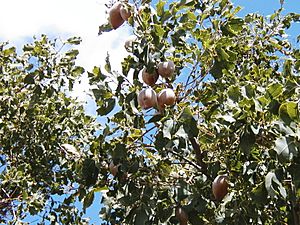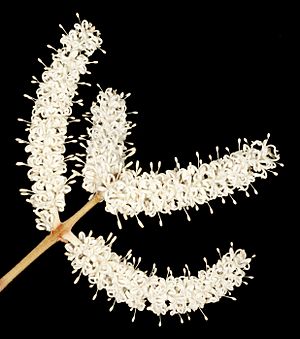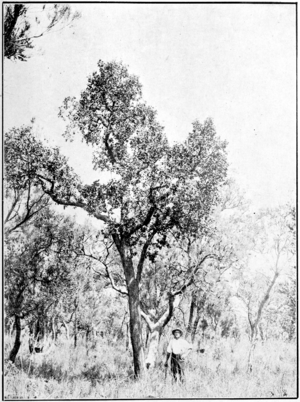Western woody pear facts for kids
Quick facts for kids Western woody pear |
|
|---|---|
 |
|
 |
|
| Scientific classification | |
| Genus: |
Xylomelum
|
| Species: |
occidentale
|
The Xylomelum occidentale, also known as the western woody pear, is a special type of tree. It belongs to the Proteaceae plant family. This tree is found only in Western Australia, which means it is endemic there.
What's in a Name?
The Noongar peoples, who are Aboriginal people from Western Australia, have their own names for this plant. They call it danja, dumbung or koongal.
A scientist named Robert Brown first described this plant in 1830. The second part of its scientific name, occidentale, comes from a Latin word. It means 'western', which makes sense because the tree grows in Western Australia!
What it Looks Like
This tree or shrub usually grows to be about 2 to 8 meters tall. That's like two to four times the height of an adult! It has special buds called epicormic buds. These buds can sprout new growth from under the bark, even after a fire.
The western woody pear blooms between December and February. Its flowers are a creamy white color. They have soft, silky hairs and are a yellowish color. These flowers grow on spikes at the ends of the branches.
The fruit of this tree looks a lot like a 'pear'. It can be over three inches long and nearly two inches wide. When the fruit is ripe, it splits open along one side. The edges of the leaves are a bit spiny. The tree's bark is grey to black and has small cracks. It stays on the tree for a long time.
Where it Grows
You can find the western woody pear in the South West, Peel, and Swan Coastal Plain areas of Western Australia. It likes to grow in sandy soils.
This species has wider leaves than its close relative, the Xylomelum angustifolium. That other tree is found more to the east. However, both trees have similar-looking fruit.


